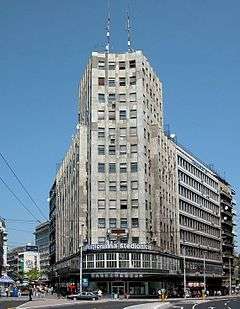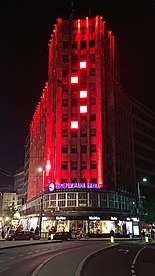Palace Albanija
| Palace Albanija | |
|---|---|
 Palace Albanija in 2010 | |
 Location within Belgrade | |
| General information | |
| Architectural style | Modernist style |
| Location | Belgrade, Serbia |
| Completed | 1940 |
| Technical details | |
| Floor count | 13 |
| Design and construction | |
| Architect |
Miladin Prljević Đorđe Lazarević |
| Other designers |
Branko Bon Milan Grakalić |
Palace Albanija (Serbian: Палата Албанија, Palata Albanija) is a high-rise building in Belgrade, Serbia. Opened in 1940, it was the first skyscraper in Southeast Europe.
Location
It is located at the north-west end of Terazije square, at the forking of four streets: Terazije, Kolarčeva, starting point of Knez Mihailova and Sremska. The latter two are pedestrian zones. In the vicinity are the Republic Square, to which both the Kolarčeva and Knez Mihailova lead, historical neighborhood of Obilićev Venac along the Knez Mihailova, and busy commercial neighborhood of Zeleni Venac, via Sremska. Palace Albanija directly faces another major edifice on Terazije, Hotel Moskva.[1][2]
Origin
It was designed by Miladin Prljević and Đorđe Lazarević, based on the 1938 project by Branko Bon and Milan Grakalić. It was the first highrise building in Belgrade and for a long time the tallest one, dominating the architecture of Belgrade of the time. The origin of its name is traced back to the period before it was built, since the kafana named Albanija previously occupied the same spot.
The clock in front of the kafana was the first public clock in Belgrade.[3]
Construction

Though small but highly popular, the demolition of the old kafana Albanija sparked mass demonstrations in 1938.[4] The project envisioned three floors below the ground. As the city government had no machinery required for the job, they invited the Kalmyks, emigrants from Russia, noted for their horses. With their horses and carts, the Kalmyks removed the rubble and earth from the foundation pit.[5]
In the relatively shallow depth, just below the old foundation, a well preserved skeleton of a mammoth was excavated in 1938, below the former door of the kafana. It was estimated to be 2 million years old, when the area of Belgrade was the edge of a Quaternary lake. The skeleton was almost undisturbed, with especially well preserved mandible with teeth, which were used to identify the species. The ribs and femurs were also in excellent shape. The bones were transported to the Museum of Serbian Land.[6]
The building was finished in 1940.
World War II
The building was hit during the heavy „Easter bombing“ of Belgrade by the Allies on 16 April 1944.[7] On 20 October 1944, Yugoslav flag with red star placed on Palace Albanija declared that Belgrade was liberated from the Nazis by the Red Army and Yugoslav Partisan forces.
Birds
In June 2018 it was announced that 3 nesting couples of Alpine swift were spotted on the building, which is the first time this happened in Belgrade. Previously, the closest nesting colony of Alpine swift was 200 km (120 mi) to the east, in the Iron Gates gorge. They were first spotted flying in the flocks of common swift, which are abundant in the city, and later the nests were found. This is taken as one of the hints that the continental climate of Belgrade changes, shifting to the Mediterranean climate.[8]
References
- ↑ Tamara Marinković-Radošević (2007). Beograd - plan i vodič. Belgrade: Geokarta. ISBN 86-459-0006-8.
- ↑ Beograd - plan grada. Smedrevska Palanka: M@gic M@p. 2006. ISBN 86-83501-53-1.
- ↑ Goran Vesić (14 September 2018). "Прва европска кафана - у Београду" [First European kafana - in Belgrade]. Politika (in Serbian). p. 12.
- ↑ Slobodan Kljakić (25 March 2012), "Na Dorćolu otvorena prva kafana u Evropi", Politika (in Serbian)
- ↑ Dimitrije Bukvić (27 March 2017). "Potomci Džingis Kana u Beogradu". Politika. p. 9.
- ↑ "Ispod temelja nekadašnje "Albanije" iskopan je kostur mamuta koji je tu počivao dva miliona godina", Politika (in Serbian), 1938
- ↑ J. Gajić (15–16 April 2017). "Na praznik padale bombe" (in Serbian). Politika. p. 27.
- ↑ Branka Vasiljević (5 June 2018). "Bela čiopa novi stanovnik belog grada" [White (Alpine) swift new inhabitant of the white city]. Politika (in Serbian). p. 15.
Coordinates: 44°48′54″N 20°27′36″E / 44.81500°N 20.46000°E